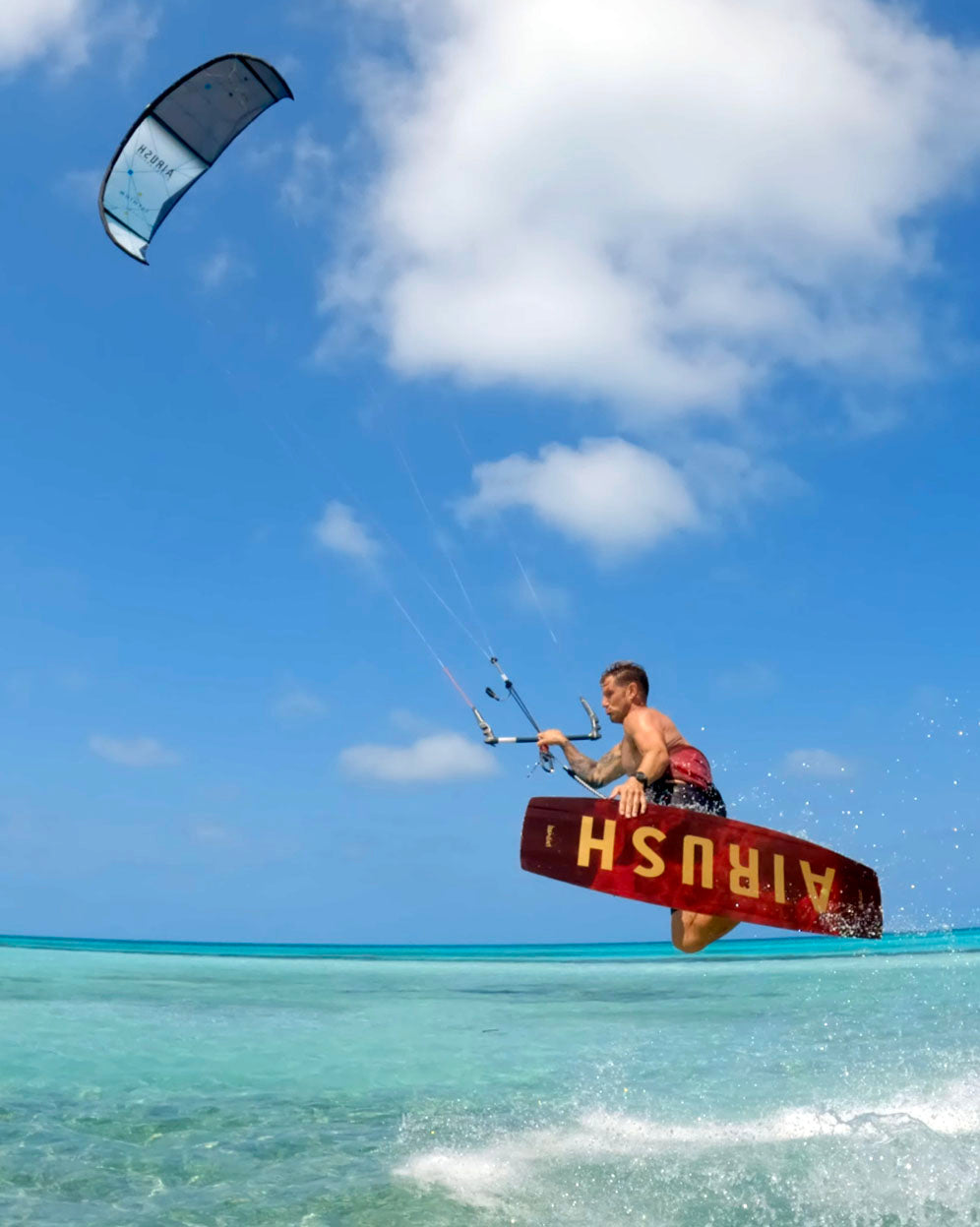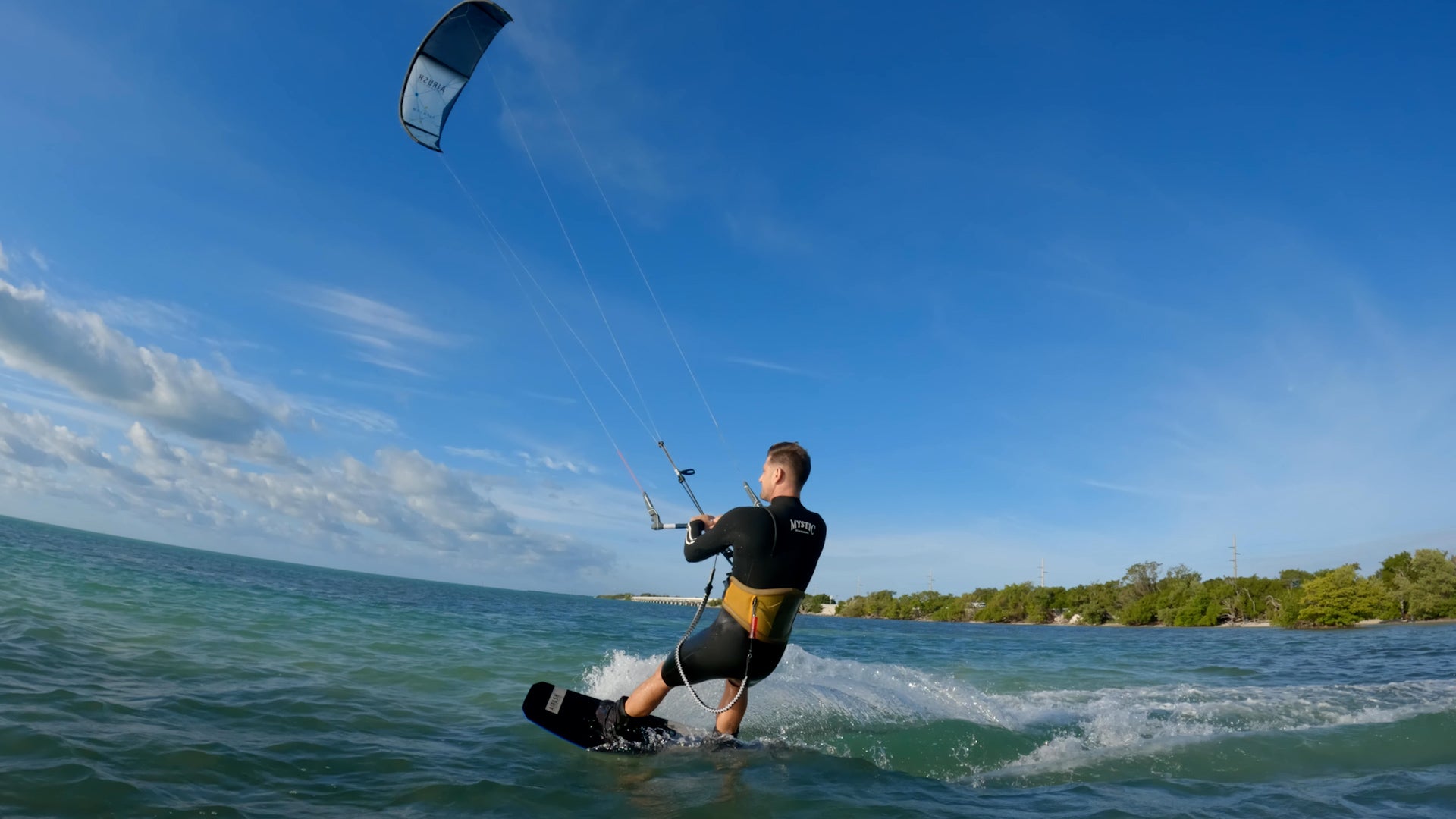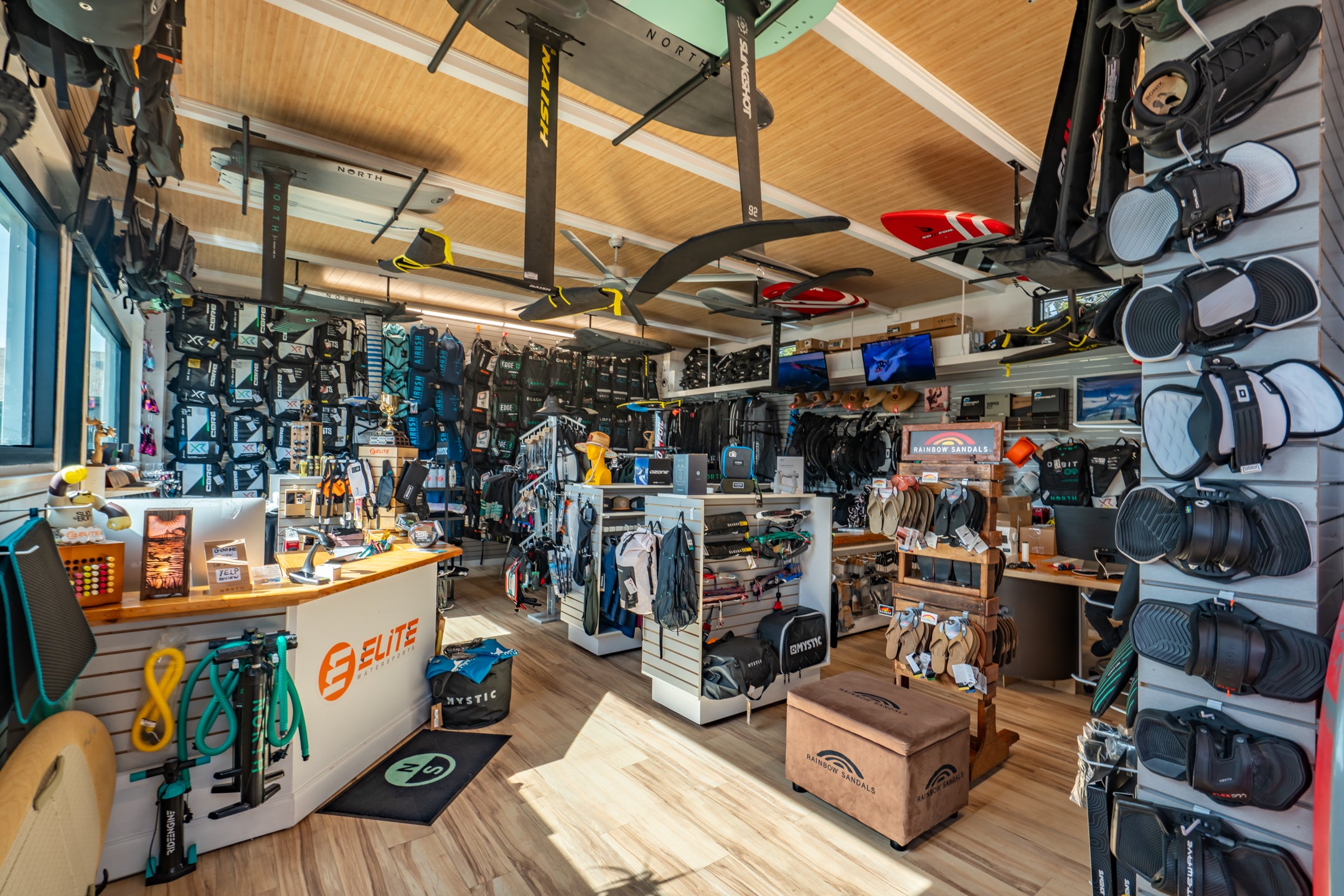ELITE WATERSPORTS
Last updated 10-21-2024
What are the parts of a kiteboarding setup?
Everything you need to know.

How does kiteboarding work?
Kiteboarding is a relatively young water sport powered by the wind and a specialized kite. But what exactly makes a kiteboarding kite fly, and how does it pull you across the water?
In this blog, we'll dive into the fundamentals of kite design, the aerodynamics at play, the different types of kites available, and how your kiteboarding gear comes together.
When it comes to understanding how a kiteboarding kite works, it's not essential but fun to grasp its aerodynamic principles, similar to those of an airplane wing or a sail. Kites generate lift due to the pressure differences between the top and bottom surfaces when wind flows over the canopy.
The kite's leading edge creates high-pressure airflow underneath and lower pressure above, creating lift.
We’ll share the mechanics but we will also break down the types of kiteboarding kites, the parts of a kitesurfing kite and types of kiteboards.




Table Of Content
- How does a kiteboarder sail?
- Types of Kiteboarding Kites
- What are the parts of a kiteboarding kite?
- What are the parts of a kiteboarding control bar?
- What is a kiteboarding harness?
- What is a kiteboard?
- What types of kiteboards are there?
How does a kiteboarder sail?
A rider will be harnessed into the kite and riding on a kiteboard. When the kite pulls the rider forward, the board will resist the pull of the kite. The energy has to go somewhere; thus, riders can angle their board into the wind and ride in a few different directions. Downwind, across to the wind and into the wind slightly. To go the other way, they set the kite to the left or the right. It's similar to how a sailboat works. Here's a breakdown of how different kite styles and features impact your ride.
Kite Aerodynamics:
Lift & Drag: The kite's shape allows it to lift the rider by creating a difference in air pressure. However, drag is also a factor that can slow the kite down. Advanced kites are designed to reduce drag while maximizing lift.
Depower: Kiteboarding kites have a depower system that lets you adjust the angle of attack to manage the power the kite delivers. Pulling in the bar can increase power while pushing it out can reduce power by changing the kite's angle.
There is more to it than that, but this is the general idea. The kite's motion and position in the sky will impact power and depower.


Kiteboarding aerodynamics
Lift: The kite's shape forces the wind to travel faster over the top than beneath it, creating lift that helps pull you across the water.
Angle of Attack: This is the angle at which the kite faces the wind. By changing this angle using your control bar, you can increase or decrease airflow and the pull from the kite.
The Wind Window: The wind window is the area downwind from where you're standing.
You'll get more or less power depending on where your kite is in the window.
Types of Kiteboarding Kites
Kiteboarding kites come in different shapes and styles, each offering unique benefits for different riding conditions. Here are some of the most popular kite styles:
C Kites: These are the most traditional and recognizable kite shapes. Known for their direct feel and responsiveness, they are popular with advanced riders who enjoy aggressive riding styles and unhooked tricks. However, they take time to learn how to use it properly as a rider must use their board edge skills to control the kite. They are rate these days as only pros use them.
Bow Kites: Bow kites have a flatter shape and offer a wide wind range, with excellent depower capabilities. These kites are great for beginners due to their safety features and ease of use.Many modern kites have bow kite DNA.
Hybrid Kites: As the name suggests, hybrid kites blend the best features of all kite designs. They offer a mix of depower and direct steering, making them ideal for intermediate riders looking to progress. Most modern kites are some form of Hybrid.
Delta Kites: Delta kites are easy to relaunch and provide excellent stability. These are often the go-to for beginner riders because of their friendly handling. These kites will have swept-back wingtips rather than square or boxy wingtips.
Ram Air Foil Kites: Unlike traditional inflatable kites, these kites do not have an inflated leading edge or struts. They are lightweight and ideal for snowkiting or land-based kiteboarding but are less common for water kiteboarding due to their lack of buoyancy.
Most modern kites are a hybrid design these days. There are too many styles and designs to break down in this blog. Call the shop if you want to learn more about modern kiteboarding kites. Generally, advanced riders opt for C hybrids for their performance, while most riders gravitate towards a delta hybrid for ease of use and air time.
New big air kites are a category of their own, and these lines are becoming more blurred.


How many struts does a kiteboarding kite have?
Strut Configurations:
Struts play a significant role in how a kite handles. Different strut configurations impact a kite's stability, performance, and wind range:
No-Strut Kites: Ultra-lightweight kites are designed for minimal drag and are perfect for foiling in light winds but are challenging to relaunch in water.
1-Strut Kites: Designed for light wind conditions, offering easy relaunch and great low-end performance. These are amazing for kitefoiling and for lighter riders in the waves. They’re pivotal, playful, and you can loop them with no power to focus on riding a hydrofoil or wave.
3-Strut Kites: An excellent all-around option, balancing agility, power, and stability. The most popular choice, these kites have a lot of support for stronger winds. They can be aimed at a specific discipline but are generally built to do it all, sometimes with an emphasis on a trending discipline of the time.
5-Strut Kites: Typically used in higher winds, these kites are more stable and handle stronger gusts, making them a favorite among experienced riders. Built for big air and riding lit, they’re made for the strongest winds. Sometimes, you’ll see all-around kites with five struts, but they are mostly big-air optimized and built for loops. Freestyle C kites are built for unhooked wakestyle, and five struts are used for support.
What are the parts of a kiteboarding kite?
A complete kiteboarding setup includes several components that work together to give you control over the kite.
Kite: Comprised of the leading edge, struts, canopy, and bridles. The leading edge is the inflatable section that gives the kite its structure and buoyancy, while the struts keep the canopy rigid. The bridles help distribute load and assist with depower.
Leading Edge: The inflatable part of the kite that keeps its structure and buoyancy. These can be Dacron or a specialty material like Hoopika from Airush or Allula, which many brands use. Specialty materials cost more to produce but are lighter and stronger.
Canopy: The main surface area of the kite is made from a material called ripstop. There are many ways to stitch these. Some brands, like Airush, implement a load frame with ultra-PE materials to improve longevity.
Struts: These provide the kite's framework and help maintain its shape during flight. The discipline a kite is built for will dictate the struts. Most all-around kites are 3-strut designs.
Bridles: These lines distribute the load and assist with depower. C kites don't have bridles, giving a more direct feel. Some bridals have a pulley system, while others are more direct. Pulleys can help with depowering, steering while fully sheeted out, and how well a kite absorbs the gusts. Some kites have unique designs where a single pulley is used with a stopper ball to improve loop performance. Most notably, the Airush Lift V3 and the Lithium V14 lead the charge with specialty bridal systems.

What are the parts of a kiteboarding conrol bar?
What are the parts of a Kiteboarding Control Bar? The bar is what connects you to the kite, and it has several parts, including:
Pigtails: These are the knots that connect the lines to the kite.
Steering Lines: The outer lines that control the kite’s direction. Pulling on either side of the bar steers the kite in that direction.
Front Lines: The inner lines that support the kite and help with depower by adjusting the angle of attack.
Mainline or Centerline: A single line that allows for sheeting in and out, which adjusts the kite's power. Sheeting is the process of changing the length of the steering lines. By pulling the bar closer, you increase power; by pushing it away, you decrease power.
Note: depending on where the kite is in the wind window, this might not always be the case with power and depower. It has more to do with adjusting the angle of attack. A good kite pilot will have the experience to sheet accordingly in all situations.
Chicken Loop: Connects the control bar to your harness, keeping you tethered to the kite. This will have a harness pin to lock the loop in.
Trim system: This system is set up where the front lines merge with the center line. A rider can adjust the length of the front lines for further kite trimming. This also adjusts the angle of attack.
Safety System: A mechanism that lets you eject or "quick release" the kite in emergencies, reducing power by flagging the kite on one line.
Bar Floats: This is the thicker area between the bar and lines. Bars usually have some kind of float when a rider falls in the water.
What is a Kiteboarding Harness?
The harness connects you to the chicken loop, distributing the kite's pull through your body. They will always have a spreader bar, hook, or rope for the control bar to connect to.
There are several styles:
Waist Harnesses: Best for mobility and athleticism.
Seat Harnesses: Best for comfort and ease of use. Popular for people with back issues.
Low Profile Seat Harnesses: These are popular with women due to their smaller size, allowing the bar to sit closer for riders with shorter arms.
Kite Shorts: A stylish variation of a seat harness that looks like a pair of board shorts.
Hardshell: A low-profile waist harness offering extra support.
Soft Shell: A high-profile waist harness focused on flexibility.
Hybrid: A medium-profile harness with good support and flexibility.


What is a Kiteboard?
There are various styles of kiteboard designs.The most popular is a twintip.
Twintip: Similar to a wakeboard with less rocker. Can be paired with footstraps or boots. There are many styles of twintip shaped for multiple disciplines: Big Air, Freestyle, Lightwind, Wakestyle, Freeride, and beyond.
Kitesurfboards: Similar to a glass surfboard but stronger with an edge made to sail and ride waves. Like twin tips, there are many specialty designs like strapless freestyle, big waves, small waves, and more.
Foil boards: These are specially gear. You can read more about foiling in our blog on light wind kiteboarding here.
Choosing the Right Kiteboarding Setup:
Hopefully, this blog helps you understand the technical side of kiteboarding equipment. If you need help picking out kiteboarding gear, email or call us at the shop. We're happy to help you decide on the perfect kiteboarding setup for you.
Why Elite Watersports?
The expert team at Elite Watersports is here to serve. If you have any kiteboarding related questions call us. We can build custom kiteboarding packages, book kiteboarding lessons or simply offer helpful advice. We're your one stop shop for kiteboarding knowledge.
Swing by the shop and say hello!
If you need help deciding on your first kiteboarding kite give Elite Watersports a call. We're happy to set you up with your first kiteboarding kite.
(727)-800-2202



Author

Ryan "Rygo" Goloversic
Tags
Kiteboarding
You May Also Like
Want To learn more about kiteboarding?
Follow us to receive the latest update on our journey experience




